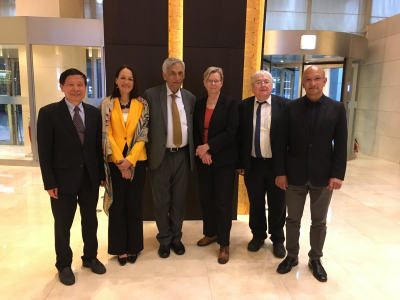


The InterAcademy Partnership (IAP) held its triennial General Assembly in Songdo, Korea, on 11 April 2019. The meeting, hosted by the Korean Academy of Science and Technology (KAST), brought together over 100 representatives of science academies from 54 countries as well as the four IAP regional networks and the Global Young Academy.
This gathering marked changes to the composition of the IAP Steering Committee, the decision-making body regarding the strategic direction of IAP. It comprises the six co-chairs of its three constituent networks –Science, Health, and Policy.
Cherry Murray (USA) and Peggy Hamburg (USA) replace Volker ter Meulen (Germany) and Detlev Ganten (Germany) as Co-chairs of IAP for Science and IAP for Health, respectively. They join the four incumbent IAP co-chairs, Richard Catlow (UK), Daya Reddy (South Africa), Depei Liu (China) and Krishan Lal (India).
“I am thrilled to be part of this partnership of national academies, and am looking forward to IAP making even more impact on global science policy, policy for global science, and furthering the use of science to enable global sustainable development, represented by the United Nation's Sustainable Development Goals, the SDGs” says Cherry Murray.
“In doing this, I would like to make sure that we are more inclusive, including bringing diverse intellects into the partnership, including engineering and young voices. The challenges we face as humankind and the solutions we need to meet them are local, regional and global all at the same time, and that is exactly what IAP represents,” she added.
“I am very excited to be a part of the leadership team of this important and unique organization as we position it for ever greater impact in addressing the pressing challenges of our increasingly complex and rapidly changing world,” says Peggy Hamburg. “IAP must be a powerful voice for science and health—both in support of education and practice—and must help ensure that the best possible evidence and science-based decision-making informs policies at every level.”
Over the course of her career in physics, Murray has held prominent appointments in industry, academia, and the public sector, while Hamburg is a distinguished physician and public health administrator as well as President of the American Association for the Advancement of Science (AAAS). Murray and Hamburg were nominated by NAS President Marcia McNutt and NAM President Victor Dzau, respectively.
The IAP General Assembly followed the two-day conference ‘Science and the Sustainable Development Goals: The Role of Academies’, attended by nearly 200 leading scientists, policy practitioners and delegates from 54 science, medical, and engineering academies from around the world.
“The conference highlighted how the UN’s SDGs are being implemented at global, regional and national levels, and the opportunities these present for the academies to better play their part. Whether they are large or small, new or old, their actions are critical because policy design and implementation generally takes place at the national level,” said Professor Volker ter Meulen, IAP president and outgoing IAP for Science Co-chair.
“To fulfill their potential to support the implementation of the SDGs, national science academies need to shift from working for society to working with society, openly and inclusively. They must bridge the gap between knowledge production and knowledge use, push for evidence-informed policies, and help build a sustainable planet,” added Professor Depei Liu, IAP President and IAP for Health Co-chair.
More about the InterAcademy Partnership
Under the umbrella of the InterAcademy Partnership (IAP), more than 140 national and regional member academies work together to support the vital role of science and its efforts to seek solutions to the world’s most challenging problems. IAP’s member academies are merit-based and typically independent of government, allowing them to provide authoritative evidence to inform policy and decision-making. IAP member academies represent more than 30,000 of the world’s most respected scientific, medical and engineering leaders in over 100 countries across Africa, the Americas, Asia-Pacific and Europe.
For more information see www.interacademies.org and follow @IAPartnership on Twitter.
IAP Governance 2019-2021
IAP Presidents:
Volker ter Meulen, Past President, German Academy of Sciences Leopoldina
Depei Liu, Past President, Chinese Academy of Engineering
IAP Policy
Co-Chairs:
Richard Catlow, Foreign Secretary, The Royal Society UK
Daya Reddy, Past President, Academy of Science of South Africa
IAP Science
Co-Chairs:
Krishan Lal, Past President, The Indian National Science Academy (INSA)
Cherry Murray, Member, US National Academy of Sciences and US National Academy of Engineering
IAP Health
Co-Chairs
Peggy Hamburg, Foreign Secretary, The US National Academy of Medicine
Depei Liu, Past President, Chinese Academy of Engineering
